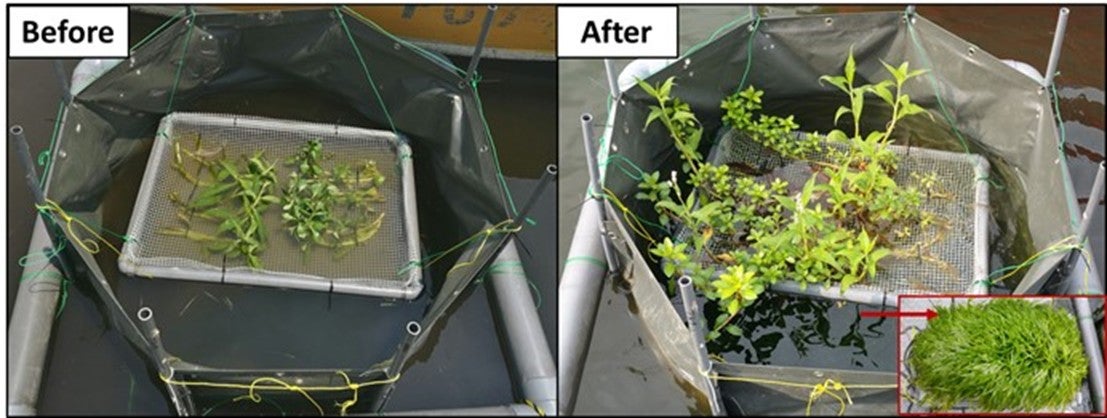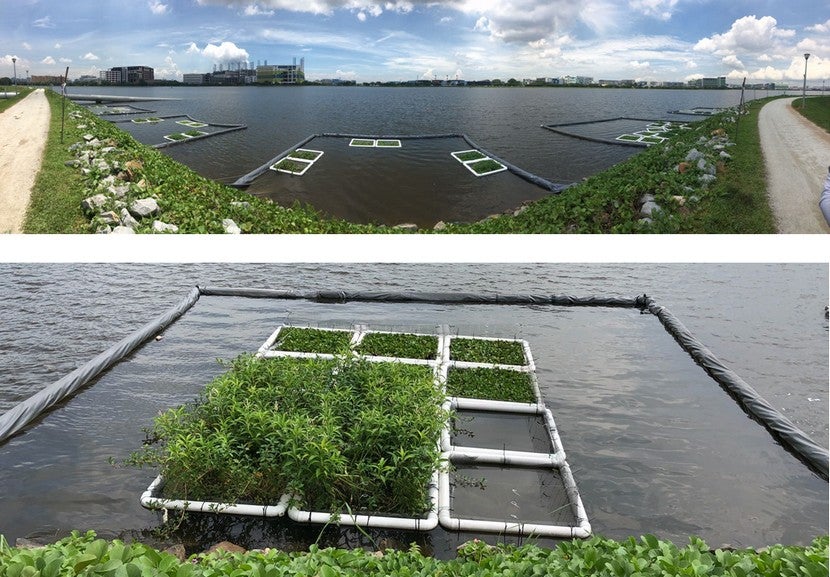Improving reservoir water quality with aquatic plants: Benefits and challenges
Darren YEO (Group Leader, Biological Sciences) April 20, 2020NUS ecologists have revealed some of the capabilities of aquatic plants to enhance the water quality of our reservoirs.
Aquatic plants (known as macrophytes) perform vital roles in freshwater ecosystems, including providing habitats for wildlife, removing or reducing nutrients, and stabilising the substrata. Macrophytes also help to maintain clear-water conditions in lakes and reservoirs, due to their ability to compete with and inhibit phytoplankton (i.e., microscopic algae), which would otherwise cause the water to appear green and murky. Good water clarity in turn boosts macrophyte growth, in a positive cycle that further stabilises the low-phytoplankton abundance, clear water state.
Following a two-year study in partnership with the PUB, Singapore’s National Water Agency, a research team led by Prof Darren YEO Chong Jinn and Prof Hugh TAN Tiang Wah from the Department of Biological Sciences, NUS, together with Prof Simon MITROVIC from the University of Technology, Sydney, have found that an artificial floating wetland comprising water banana (Ludwigia adscendens) and knot grass (Persicaria barbata) can trigger marked improvements in water clarity in 1,000-litre in-situ experiments deployed at Pandan Reservoir. The team also included project manager and research fellow, Dr Maxine MOWE and graduate student Darren SIM, whose Ph.D. study is centred on this project.
While floating wetlands have been deployed in various water bodies to enhance water quality and provide wildlife habitat, as part of PUB’s Active, Beautiful, Clean Waters (ABC Waters) programme, this study seeks to optimise their restorative potential.
“Many aquatic plants have tremendous potential for controlling nuisance algae in our reservoirs,” said Mr Sim. “Interestingly, we also found that the fully-aquatic tapegrass (Vallisneria spiralis) could synergise with other wetland plants for stronger effects against cyanobacteria or blue-green algae, which are most often responsible for undesirable effects of algal blooms, including production of toxins, taste and odour, and poor water clarity.”
Another type of floating plant, the water hyacinth (Eichhornia crassipes) showed similar effects on phytoplankton and water clarity but had an even greater ability to remove excess nutrients from the water. Dr Mowe commented, “Although water hyacinth has a reputation as an invasive species, it can be useful in this instance to compete against phytoplankton growth and has been previously used for wastewater treatment in other countries.”
Based on the findings from the 1,000-litre mesocosms, the study was scaled up even further with floating wetlands planted with water banana, knot grass, and water hyacinth and trialled in larger 250,000-litre mesocosms to evaluate their effectiveness at a larger scale. While initial results were promising, the team quickly encountered unforeseen challenges involving local wildlife. Although the wetlands frequently attracted smooth-coated otters, birds and insects, some of these animals also inadvertently damaged the macrophytes while they were still vulnerable.
Despite initially suppressing phytoplankton, the macrophytes could not sustain these effects over time. Worsening this situation were the strong winds and waves at Pandan reservoir, that impacted the macrophytes’ survival.
This study nevertheless provided invaluable lessons for reservoir-enhancement efforts. Floating wetlands continue to be an attractive option for creating unique waterfront spaces in Singapore, and their functionality could be augmented to improve water quality through the careful selection and maintenance of macrophytes. Submerged macrophytes, often maligned as weeds, could also play a role in regulating phytoplankton abundance.
While the field component of the project with the PUB has concluded, laboratory investigations on one of the mechanisms behind the ability of these aquatic plants to inhibit phytoplankton, namely through anti-algal chemical properties, are continuing. Mr Sim said, “Tests indicate that these plants produce potent anti-algal compounds which could be harnessed to improve reservoir water quality.”
“This project represents an important example of a biological approach to tropical urban freshwater management, which fits in with the growing emphasis on nature-based solutions to environmental issues,” added Prof Yeo.

Figure 1: Mesocosms stocked with water banana, knotgrass and tapegrass, at the start of the experiment (before) and after 28 days. Aquatic plants could dramatically increase water clarity and reduce cyanobacterial biomass by as much as 99.3%. [Photograph credit: Darren Sim]

Figure 2: (Top) Panoramic view of the mesocosms used in the large-scale experiment at Pandan Reservoir. (Bottom) Experimental floating wetlands setup within mesocosms. At 250,000 litres in volume, these mesocosms represent a massive scaling up from the previous 100- and 1,000-litre mesocosms, necessary to replicate environmental conditions more closely. [Photograph credit: Maxine Mowe]


